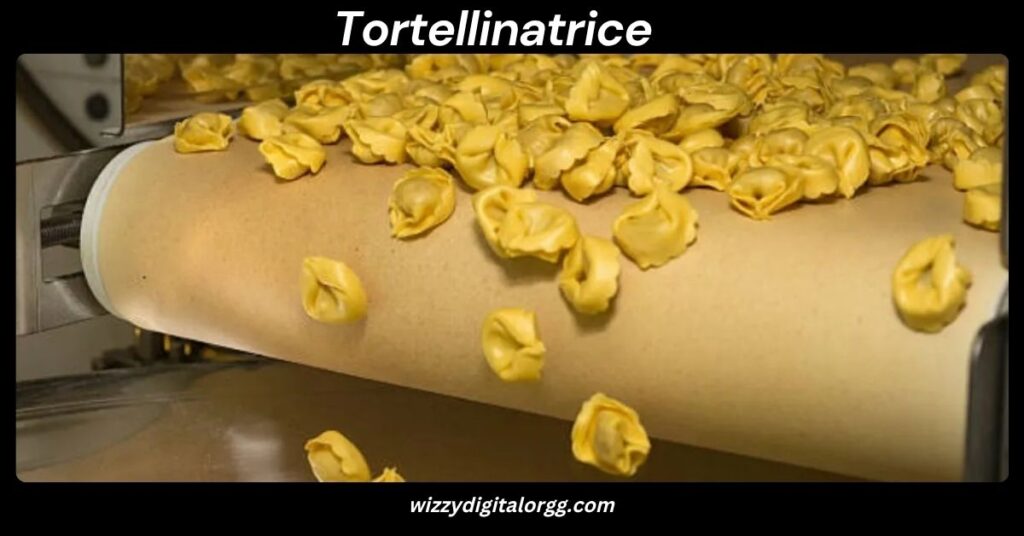
In traditional Italian cooking, few dishes are as iconic and cherished as tortellini. These small, ring-shaped pasta pieces are typically filled with savory mixtures such as meats, cheeses, or vegetables and are often served in a rich broth or creamy sauce. However, making tortellini by hand can be a long and tricky process. This is where the tortellinatrice comes into play.
The tortellinatrice is a unique kitchen machine designed to help cooks—whether they are home enthusiasts or professional chefs—create perfectly shaped tortellini quickly and easily. By using this device, you can enjoy the satisfaction of making authentic Italian pasta without spending hours folding each piece by hand.
What Is a Tortellinatrice?
A tortellinatrice is a specialized machine that shapes tortellini automatically. It takes rolled-out pasta dough and a prepared filling, then shapes, folds, and seals the pasta into the traditional tortellini ring.
This kitchen tool can be manual, electric, or industrial, and its function is to simplify the repetitive and precise motions required to create consistent, bite-sized tortellini. With the right technique and quality ingredients, the tortellinatrice enables anyone to replicate the traditional pasta found in the finest Italian kitchens.

Tortellinatrice machines are popular among:
- Home cooks who want to recreate traditional recipes
- Small restaurants aiming for homemade quality with faster output
- Pasta artisans and caterers who prepare large batches
Why Use a Tortellinatrice?
Saves Time
Making tortellini by hand is an art, but it takes a lot of time. For one dinner, you might need to shape over 100 tortellini. A tortellinatrice can produce dozens per minute, helping you save hours of labor without compromising on quality.
Ensures Consistency
Handmade pasta often results in pieces that vary in size and thickness. A tortellinatrice produces uniform tortellini, making sure that each one cooks evenly and looks appealing on the plate. This consistency is especially important in restaurants and catering businesses.
Also Read: scoopupdates .com: Everything You Need To Know
Easy to Use
These machines are designed with ease in mind. Whether manual or electric, most tortellinatrice models have simple interfaces and clear instructions. Once you’ve prepared the dough and filling, the machine handles the most complex part.
Encourages Homemade Cooking
People are often intimidated by making filled pasta at home. The tortellinatrice lowers the barrier and invites more people to experiment with fresh, homemade tortellini, leading to healthier and more satisfying meals.
Types of Tortellinatrice
Manual Tortellinatrice
These are hand-powered machines where you roll the pasta manually and use attachments or molds to shape the tortellini. They are perfect for beginners or people who want a traditional, hands-on experience.
Pros:
- Inexpensive
- Great for occasional use
- No electricity needed
Cons:
- Slower than electric models
- Requires more physical effort
Electric Tortellinatrice
Electric models automate the process. Some even have a built-in dough roller and cutter. These are ideal for serious home cooks and small businesses.
Pros:
- Faster production
- Consistent results
- Less physical work
Cons:
- More expensive
- Needs power source
Industrial Tortellinatrice
These are large machines used in pasta factories or commercial kitchens. They can produce thousands of tortellini in a single day.
Pros:
- Extremely high output
- Durable for long-term use
Cons:
- Very expensive
- Requires maintenance and space
Features to Look For
When choosing a tortellinatrice, consider these important features:
- Material Quality: Stainless steel machines are durable and resistant to rust. Cheaper plastic models may break over time.
- Ease of Assembly and Cleaning: Look for machines with removable parts that can be washed separately.
- Size and Storage: Make sure the machine fits on your countertop or in your storage space.
- Speed Settings: Some electric models allow speed adjustments to control production.
- Filling Capacity: A good machine should be able to hold enough filling to make several tortellini before needing a refill.
- Customizable Shapes: Some advanced models offer the ability to switch dies for different pasta shapes.
Also Read: Rapelusr: The Future of Smart News Reporting Powered by AI and Data Science
How to Use a Tortellinatrice
- Prepare the Dough: Mix flour and eggs to make a firm yet pliable dough. Let it rest for 30 minutes.
- Roll the Dough: Roll out thin sheets of dough using a roller or the machine’s roller attachment.
- Prepare the Filling: Mix your preferred filling—meats, cheeses, vegetables—into a fine consistency.
- Load the Machine: Insert the pasta sheet and fill the hopper with the stuffing.
- Run the Machine: Turn the handle or press the start button. The machine folds, fills, and cuts the tortellini.
- Collect and Arrange: Lay out the tortellini on a floured tray. Let them dry slightly before cooking or storing.
Cleaning and Maintenance
To keep your tortellinatrice in good shape:
- Clean it right after use
- Use a small brush to remove leftover dough
- Disassemble any removable parts
- Wash parts with warm, soapy water (if dishwasher safe, use top rack)
- Let all parts air dry fully
- Store in a dry area to avoid mold or rust
Homemade vs. Store-Bought Tortellini
Store-bought tortellini may be convenient, but they lack the freshness and taste of homemade versions. When using a tortellinatrice, you can:
- Control the ingredients (organic, gluten-free, vegetarian)
- Customize the fillings to suit your taste
- Avoid preservatives and artificial flavors
Homemade tortellini with a tortellinatrice gives you restaurant-quality results at home.
The History of Tortellini
Tortellini originated in the Emilia-Romagna region of Italy, especially in Bologna and Modena. One romantic legend says they were shaped after the navel of the Roman goddess Venus. Historically, tortellini were filled with pork, cheese, and nutmeg, and served in capon broth during festive occasions.
The tradition of making tortellini has been passed down through generations. The invention of the tortellinatrice has helped preserve this cultural heritage by making it easier to produce tortellini while maintaining its traditional shape and taste.
Tips for Better Tortellini with a Tortellinatrice
- Keep Dough Soft but Firm: Dry dough may crack; overly wet dough may stick
- Flour the Machine and Dough: Prevents sticking and tearing
- Don’t Overfill: Use just enough filling to avoid breakage
- Seal Edges Properly: Even pressure helps prevent leaking during cooking
- Work in a Cool, Dry Space: High humidity can affect dough consistency
- Let Tortellini Rest: Allow shaped tortellini to sit for a few minutes before cooking or freezing
Creative Tortellini Fillings
Once you’re comfortable using your tortellinatrice, explore different fillings:
- Classic Italian: Prosciutto, mortadella, Parmesan
- Vegetarian: Ricotta, spinach, garlic
- Seasonal: Pumpkin, sage, nutmeg
- Seafood: Crab, mascarpone, lemon zest
- Cheese Lovers: Gorgonzola, pear, walnuts
- Sweet Fillings: Ricotta with cocoa, or mascarpone with berries (for dessert tortellini)
Best Brands of Tortellinatrice
Marcato
Known for durability and design. Offers manual and electric models.
Imperia
Classic Italian brand with traditional styling. Ideal for beginners.
Pastidea
Focuses on quality accessories and attachments.
La Monferrina
High-end brand for professionals and small businesses.
Bottene
Popular in commercial settings for their reliability.
Also Read: quotela.net: Your Ultimate Online Destination for Inspirational and Motivational Quotes
Cost of a Tortellinatrice
The cost varies by model:
- Manual Models: $30–$80
- Electric Home Models: $100–$300
- Commercial Machines: $500–$5000+
Consider your cooking frequency and space when choosing. Home cooks may start with a manual version, while serious users may invest in an electric model.
Where to Buy a Tortellinatrice
You can buy a tortellinatrice from:
- Online retailers (Amazon, eBay, Walmart)
- Specialty kitchen stores
- Italian gourmet shops
- Manufacturer websites
Check customer reviews, warranty information, and return policies before buying.
Making Tortellini a Family Activity
Using a tortellinatrice can be a fun group activity. Kids can help roll dough or add filling. Partners can take turns with the machine. It’s a creative and tasty way to spend time together while making a meal from scratch.
Turn it into a family tradition—make tortellini for holidays, birthdays, or Sunday dinners.
Tortellinatrice vs. Ravioli Maker
Though similar in concept, these machines are not the same. A ravioli maker produces flat, square or round filled pasta, usually sealed on four sides. A tortellinatrice shapes the pasta into a ring or navel form, characteristic of tortellini.
Each machine is tailored for specific pasta types, and a tortellinatrice is ideal for replicating the classic Italian tortellini experience.
Eco-Friendly Pasta Making
Homemade pasta with a tortellinatrice supports eco-conscious living:
- Reduces packaging waste
- Encourages local ingredient sourcing
- Cuts down on factory production impact
- Minimizes food preservatives and chemicals
If you’re looking to live more sustainably, making pasta at home is a small step with a big reward.
Tortellinatrice in Restaurants
Professional kitchens rely on tortellinatrice machines to produce large quantities without sacrificing quality. These machines help restaurants offer fresh pasta daily, reduce prep time, and maintain consistency in presentation.
Chefs often customize their machines or settings to create signature pasta shapes and fillings that make their menus stand out.
Common Problems and Solutions
- Pasta Sticks: Sprinkle more flour on the dough and machine
- Dough Tears: Ensure dough is not too dry or too thin
- Filling Oozes Out: Use firmer filling; don’t overstuff
- Uneven Tortellini: Roll dough evenly before inserting
- Machine Jams: Clean regularly to avoid dough buildup
Final Thoughts
The tortellinatrice is a powerful tool for anyone who loves Italian cuisine. It bridges the gap between tradition and modern convenience, making it easier than ever to enjoy homemade tortellini.
With the right machine and a bit of practice, you can impress your guests, treat your family, and even start your own small pasta-making business. If you’re serious about pasta, investing in a tortellinatrice is a decision you won’t regret.
FAQs About the Tortellinatrice
What is a tortellinatrice?
A tortellinatrice is a machine that shapes tortellini pasta automatically.
Can beginners use a tortellinatrice?
Yes. Many models are simple to operate and beginner-friendly.
What fillings work best?
Classic meat and cheese, vegetables, or even sweet ingredients like mascarpone.
How do I clean a tortellinatrice?
Disassemble, brush off dough, wash parts with warm soapy water, and dry thoroughly.
Where can I buy a tortellinatrice?
Check Amazon, eBay, kitchen specialty stores, or Italian cookware retailers.
How much does it cost?
Prices range from $30 for basic models to $5000 for commercial equipment.
Is it worth buying a tortellinatrice?
Absolutely. It saves time and improves the quality of homemade tortellini.
Can I use it for other pasta shapes?
Some models support different attachments, but most are specific to tortellini.
What is the best brand?
Top brands include Marcato, Imperia, La Monferrina, and Bottene.
How long does homemade tortellini last?
Fresh tortellini lasts 2–3 days in the fridge, or 1–2 months if frozen properly.



